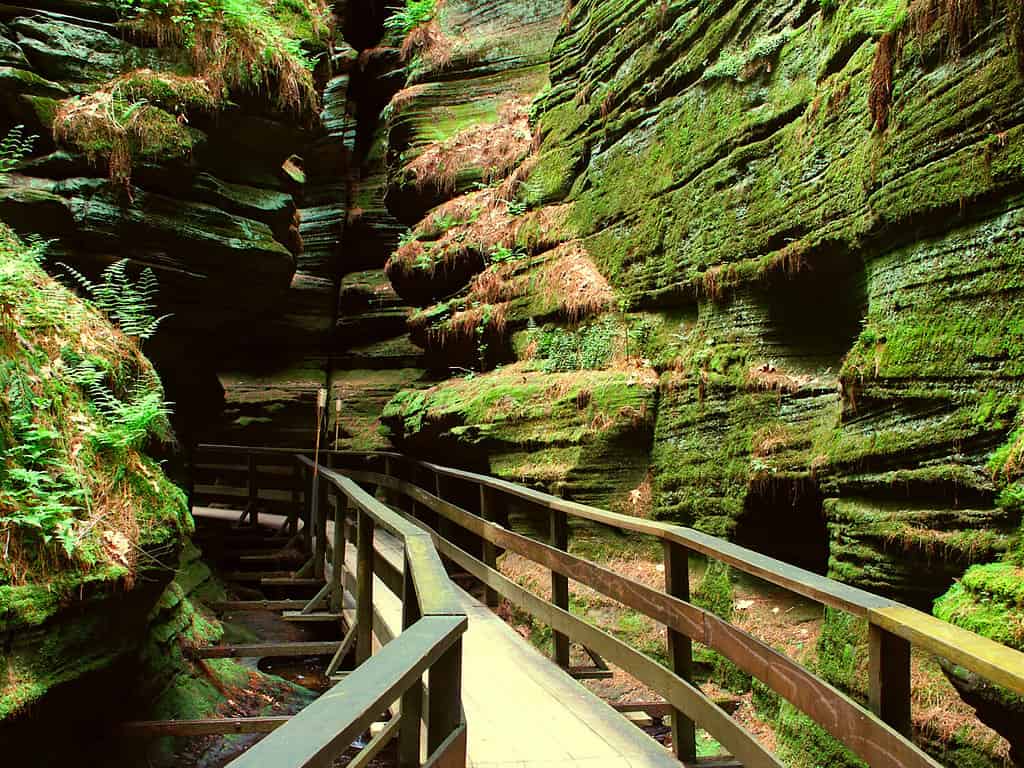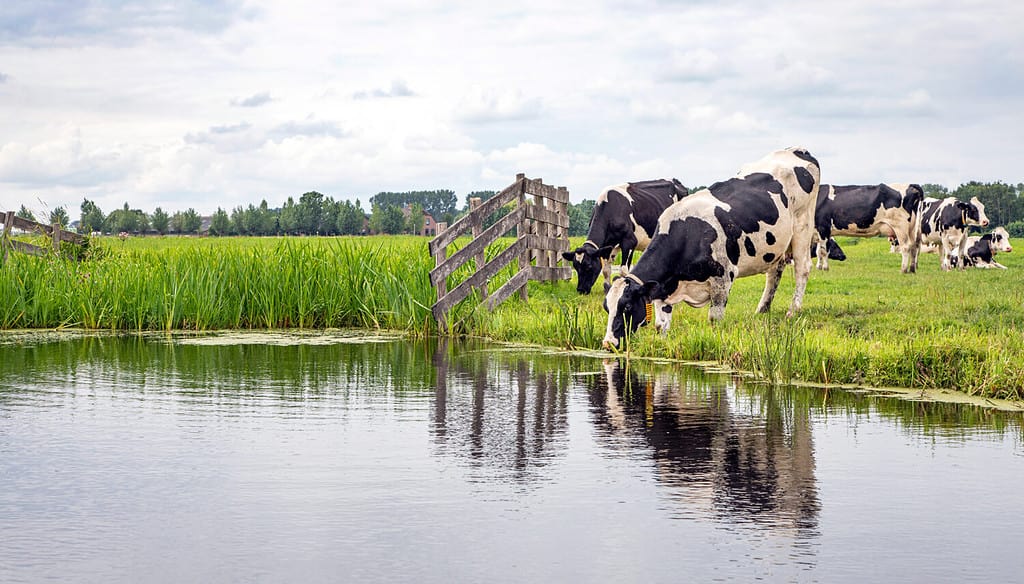You may know Wisconsin as the Cheese State or America’s Dairyland, but do you know the history of the name itself? If you don’t, don’t worry – scholars have a hard time with it, too! So how did Wisconsin get its name? Read on to discover its origin and meaning!
How Did Wisconsin Get Its Name?

Wisconsin most likely got its name from the bluffs along the Wisconsin River.
©Jason Patrick Ross/Shutterstock.com
Wisconsin most likely got its name from the red sandstone bluffs lining the Wisconsin River in Wisconsin Dells. Although the meaning and origin of the name are much debated (see the following sections for more detail), Miami Indians were probably the first people to expose Europeans to the name in 1673.
Scholars have found it difficult to trace the exact etymology of the original word for “Wisconsin.” What they do know is that the Miami Indians spoke an Algonquian language – unfortunately, the last native speakers died in the 1960s. While serving as guides through the area in the 17th century, members of this tribe spoke of the “Mesconsing” river, which was first written down as “Meskousing.” In 1935, native Ojibwe speakers broke this down into “Misko” (red), “Ahsin” (stone), and “Sin” (place). This translates roughly to “Red Stone River” or “river running through a red place.”
The Meaning of the Name “Wisconsin”
The meaning of the name “Wisconsin” has prompted much debate over the years. According to the Wisconsin Historical Society, the best translation is “river running through a red place” or “this stream meanders through something red.” Historical linguist Michael McCafferty believes this is a reference to Wisconsin Dells’ iconic red sandstone bluffs.
According to Indian Affairs, another potential meaning of the name Wisconsin is “wild rushing channel.” This would refer to the state’s primary river, the Wisconsin River. An alternative translation reads “holes in the banks of a stream in which birds nest.” In addition to this, there are several other less plausible translations of “Wisconsin,” including:
- Stream of a Thousand Isles
- Gathering of Waters
- Muskrat house
- Grassy place
European researchers gathered most of these translations from local Native American tribes during the 19th and early 20th centuries. Even then, scholars encountered some difficulty when it came to securing a consistent translation.
The Evolution of the Spelling of “Wisconsin”

The name “Wisconsin” was originally spelled in several different ways, including the French “Ouisconsin.”
©Gottography/Shutterstock.com
The name “Wisconsin” was not always spelled that way. Here is a brief history of the evolution of the spelling of “Wisconsin.”
The Early Days: “Meskousing” to “Mescousin”
The earliest recorded spelling of the word is “Meskousing.” Father Jacques Marquette, an early European explorer, and missionary, recorded this name in a journal entry in June 1673 during a canoe voyage across Wisconsin and along the Mississippi River. He wrote the entry while he and fur trader Louis Joliet stayed with Menominee Indians on Green Bay as well as with other tribes in a nearby town. He later referred to the Wisconsin River as the “Miskous.”
In 1674, Marquette’s traveling companion Joliet drew a map on which he used the word “Miskonsing” to refer to Wisconsin. In 1681, author Melchisedec Thevenot published a book about their travels in which he referred to the Wisconsin River as the “Mescousin River.”
Modern Development: “Ouisconsin” to “Wisconsin”
The current pronunciation of Wisconsin is the result of a clerical error made in 1674. Explorer Rene Robert Cavelier, Sieur de La Salle misread Marquette’s handwriting, thinking his “M” was “Ou.” He reprinted the name as “Ouisconsin” onto subsequent maps. His attempt to correct this in a 1682 report was fruitless. The new spelling had caught on, eventually totally replacing the original. Typographical errors persisted, including “Ouriconsing,” “Ouiscousen,” and “Ouiskonche.”
The transition from Ouisconsin to Wisconsin came about as a result of the influx of lead miners into the area in the 1820s. In the debates and legislation that followed, American governmental officials began to replace the “Ou” with “W.” The first recorded spelling of the modern “Wisconsin” occurred in the U.S. House of Representatives Journal on February 1, 1830. The spelling was formalized along with territorial status on July 4, 1836, though Canadians and the French often persisted in the use of “Ouisconsin” until the end of the century.
One of the most influential people in the formation of the Wisconsin Territory was James Duane Doty. Ironically, he preferred the spelling “Wiskonsin” over “Wisconsin.” His adamance eventually forced the Legislature to pass a resolution in 1845 formalizing the spelling “Wisconsin” in official usage.
Nicknames for Wisconsin

Three of Wisconsin’s nicknames, including “The Dairy State,” refer to its robust dairy production.
©Clara Bastian/Shutterstock.com
Wisconsin has garnered several nicknames throughout its history. Here is a list of common nicknames and their meanings:
- Badger State: In 1957, the state claimed the badger as Wisconsin’s state animal. Its longstanding association with the state may come from the early lead miners who spent their days digging in the ground. The badger has appeared in the state coat of arms, the flag, the seal, the State Capitol architecture, and the song “On, Wisconsin!”
- The Dairy State: This nickname derives from Wisconsin’s robust dairy production, especially cheese and butter.
- America’s Dairyland: Similar in meaning to “The Dairy State,” this nickname appears on Wisconsin license plates.
- Cheese State: This is a reference to Wisconsin’s massive cheese output. With approximately 600 varieties, it currently produces around 26% of America’s cheese, making it the top producer in the country.
- The Copper State: This nickname comes from the copper mines in northern Wisconsin.
History of Wisconsin
Wisconsin was originally the home of several Native American tribes including the Chippewa, Menominee, Oneida, Potawatomi, and Ho-Chunk (Winnebago). European explorer Jean Nicolet was the first European to arrive in the area in 1634. He discovered the state while searching for the Northwest Passage to China. France would later claim Wisconsin in 1672, though it would cede it to Britain in 1763 as part of the Treaty of Paris. Also in Paris, Britain would end up ceding Wisconsin to the United States of America twenty years later in 1783.
As part of the 1787 Northwest Ordinance, Wisconsin became part of the territory north and west of the Ohio River. It eventually took its modern form in 1836 along with Iowa, Minnesota, and parts of the Dakotas. In 1848, it became the 30th state officially accepted into the Union.
Thank you for reading! Have some feedback for us? Contact the AZ Animals editorial team.








